《农业气象学》课程教学资源(文献资料)The atmosphere
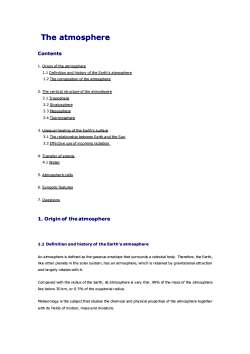
The atmosphereContents1. Oriqin of the atmosphere1.1Definitionand historyof theEarth's atmosphere1.2The composition of theatmosphere2. The vertical structure of the atmoshpere2.1 Troposhere2.2 Stratosphere2.3Mesosphere2.4Thermosphere3. Unequal heating of the Earth's surface3.1TherelationshipbetweenFarthandtheSun3.2Effective use of incoming radiation4.Transferofeneray4.1 Water5. Atmospheric cells6.Synopticfeatures7.Questions1.Originof theatmosphere1.1DefinitionandhistoryoftheEarth'satmosphereAn atmosphere is defined as thegaseous envelope that surrounds a celestial body.Therefore,the Earth,likeotherplanets in the solarsystem,hasan atmosphere,which is retained bygravitationalattractionand largely rotates with it.Compared with the radius of the Earth, its atmosphere is very thin. 99% of the mass of the atmosphereliesbelow30km,or0.5%oftheequatorialradiusMeteorology is the subject that studies the chemical and physical properties of the atmosphere togetherwith its fields ofmotion,massandmoisture
The atmosphere Contents 1. Origin of the atmosphere 1.1 Definition and history of the Earth's atmosphere 1.2 The composition of the atmosphere 2. The vertical structure of the atmoshpere 2.1 Troposhere 2.2 Stratosphere 2.3 Mesosphere 2.4 Thermosphere 3. Unequal heating of the Earth's surface 3.1 The relationship between Earth and the Sun 3.2 Effective use of incoming radiation 4. Transfer of energy 4.1 Water 5. Atmospheric cells 6. Synoptic features 7. Questions 1. Origin of the atmosphere 1.1 Definition and history of the Earth's atmosphere An atmosphere is defined as the gaseous envelope that surrounds a celestial body. Therefore, the Earth, like other planets in the solar system, has an atmosphere, which is retained by gravitational attraction and largely rotates with it. Compared with the radius of the Earth, its atmosphere is very thin. 99% of the mass of the atmosphere lies below 30 km, or 0.5% of the equatorial radius. Meteorology is the subject that studies the chemical and physical properties of the atmosphere together with its fields of motion, mass and moisture
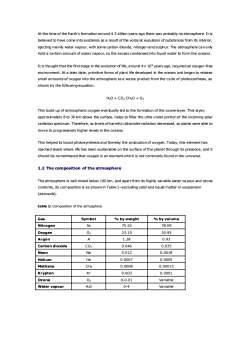
AtthetimeoftheEarth'sfomationaround4.5billionyearsagotherewasprobablynoatmosphere.Itisbelieved to have come into existence as a result of the volcanic expulsion of substances from its interior,ejecting mainly water vapour, with some carbon dioxide, nitrogen and sulphur. The atmosphere can onlyholdacertainamountofwatervapour,sotheexcesscondensedinto liquidwatertoformtheoceansIt is thought that the first stage in the evolution of life,around 4x 10° years ago,required an oxygen-freeenvironment. At a later date, primitive forms of plant lfe developed in the oceans and began to releasesmallamounts of oxygen into the atmosphere as a waste productfrom the cydle of photosynthesis,asshown by the following equation:H20 + CO2 CH20+ O02This build up of atmospheric oxygen eventually led to the formation of the ozonelayer.This layer,approximately 8 to 30 km above the surface, helps to filter the ultra -violet portion of the incoming solarradiation spectrum.Therefore,as levels ofharmful ultravioletradiation decreased, so plants were able tomovetoprogressivelyhigherlevelsintheoceansThis helped to boost photosynthesis and thereby the production of oxygen.Today,this element hasreached levels where life has been sustainable on the surface ofthe planet through its presence,and itshould be remembered that oxygen is an element which is not commonlyfound in the universe.1.2ThecompositionoftheatmosphereTheatmosphereiswell mixedbelow1ookm,andapartfrom itshighlyvariablewatervapourandozonecontents,its composition isas shown inTable1-excluding solidand liquid matter in suspension(aerosols).table1:CompositionoftheatmosphereGasSymbol%byweight%byvolumeN2Nitrogen75.5278.09oxygen0223.1520.95A1.280.93ArgonCO20.0460.035CarbondioxideNeNeon0.0120.0018HeHelium0.00070.0005CH40.00080.00015MethaneKr0.0001Krypton0.003Ozone030-0.01Variable0-4H20 VariableWatervapour一
At the time of the Earth’s formation around 4.5 billion years ago there was probably no atmosphere. It is believed to have come into existence as a result of the volcanic expulsion of substances from its interior, ejecting mainly water vapour, with some carbon dioxide, nitrogen and sulphur. The atmosphere can only hold a certain amount of water vapour, so the excess condensed into liquid water to form the oceans. It is thought that the first stage in the evolution of life, around 4 x 109 years ago, required an oxygen-free environment. At a later date, primitive forms of plant life developed in the oceans and began to release small amounts of oxygen into the atmosphere as a waste product from the cycle of photosynthesis, as shown by the following equation: H2O + CO2 CH2O + O2 This build up of atmospheric oxygen eventually led to the formation of the ozone layer. This layer, approximately 8 to 30 km above the surface, helps to filter the ultra-violet portion of the incoming solar radiation spectrum. Therefore, as levels of harmful ultraviolet radiation decreased, so plants were able to move to progressively higher levels in the oceans. This helped to boost photosynthesis and thereby the production of oxygen. Today, this element has reached levels where life has been sustainable on the surface of the planet through its presence, and it should be remembered that oxygen is an element which is not commonly found in the universe. 1.2 The composition of the atmosphere The atmosphere is well mixed below 100 km, and apart from its highly variable water vapour and ozone contents, its composition is as shown in Table 1–excluding solid and liquid matter in suspension (aerosols). table 1: Composition of the atmosphere Gas Symbol % by weight % by volume Nitrogen N2 75.52 78.09 Oxygen O2 23.15 20.95 Argon A 1.28 0.93 Carbon dioxide CO2 0.046 0.035 Neon Ne 0.012 0.0018 Helium He 0.0007 0.0005 Methane CH4 0.0008 0.00015 Krypton Kr 0.003 0.0001 Ozone O3 0-0.01 Variable Water vapour H20 0-4 Variable
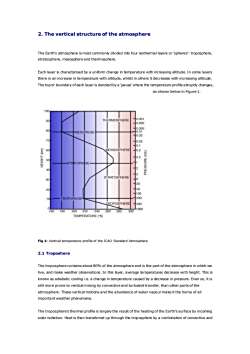
2.TheverticalstructureoftheatmosphereThe Earth's atmosphere is most commonly divided into four isothermal layers or'spheres': troposphere,stratosphere,mesosphereandthermosphere.Each layer is characterised by a uniform change in temperature with increasing altitude. In some layersthere is an increase in temperature with altitude, whilst in others it decreases with increasing altitude.The top or boundary of each layer is denoted by a'pause'where the temperature profile abruptly changes,as shownbelowinFigure1.1000.00190THERMOSPHERE0.0028.8080MESOPAUSE0.02700.02MESSOSPHERE0.26(qu)H0.550STEATOPALSE型240STRATOSPHEREo30205020100200TROPOPAUSE10500TROPOSPHERE11000160180200240220260280300TEMPERATURE (°K)Fig1:Verticaltemperatureprofileof theICAO StandardAtmosphere2.1 TroposhereThe troposphere contains about 80% of the atmosphere and is the part of the atmosphere in which welive, and make weather observations. In this layer, average temperatures decrease with height. This isknown as adiabatic cooling i.e. a change in temperature caused by a decrease in pressure. Even so, it isstill more prone to vertical mixing by convective and turbulenttransfer,than otherparts of theatmosphere.Thesevertical motions and the abundanceof water vapourmakeitthe homeof allimportantweatherphenomenaThe troposphere's thermal profile is largelythe result of the heating of the Earth's surfaceby incomingsolar radiation. Heat is then transferred up through the troposphere by a combination of convective and
2. The vertical structure of the atmosphere The Earth's atmosphere is most commonly divided into four isothermal layers or 'spheres': troposphere, stratosphere, mesosphere and thermosphere. Each layer is characterised by a uniform change in temperature with increasing altitude. In some layers there is an increase in temperature with altitude, whilst in others it decreases with increasing altitude. The top or boundary of each layer is denoted by a 'pause' where the temperature profile abruptly changes, as shown below in Figure 1. Fig 1: Vertical temperature profile of the ICAO Standard Atmosphere 2.1 Troposhere The troposphere contains about 80% of the atmosphere and is the part of the atmosphere in which we live, and make weather observations. In this layer, average temperatures decrease with height. This is known as adiabatic cooling i.e. a change in temperature caused by a decrease in pressure. Even so, it is still more prone to vertical mixing by convective and turbulent transfer, than other parts of the atmosphere. These vertical motions and the abundance of water vapour make it the home of all important weather phenomena. The troposphere’s thermal profile is largely the result of the heating of the Earth’s surface by incoming solar radiation. Heat is then transferred up through the troposphere by a combination of convective and
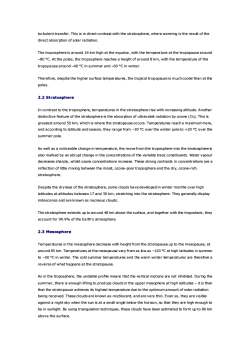
turbulent transfer.This is indirect contrast with the stratosphere, where waming is the result of thedirectabsorptionofsolarradiation.Thetroposphere isaround16kmhighattheequator,withthetemperatureatthetropopausearound-8oC.At thepoles,thetropospherereaches a heightof around8km,with thetemperatureofthetropopause around-40oC in summer and-60C in winter.Therefore, despite the higher surfacetemperatures,the tropical tropopause is muchcoolerthan at thepoles.2.2StratosphereIncontrasttothetroposphere,temperaturesinthestratosphererisewithincreasingaltitude.Anothedistinctivefeatureof thestratosphereis the absorption ofultraviolet radiationbyozone (O3).Thisisgreatest around 5o km, which is where the stratopause occurs. Temperatures reacha maximum here,and according to latitude andseason,they range from-30oC overthewinter pole to+20 Cover thesummerpole.As well as a noticeable change in temperature, the movefrom the troposphere into the stratosphere isalso marked by an abrupt change in the concentrations of the variable trace constituents.Water vapourdecreasessharply,whilstozoneconcentrations increase.Thesestrongcontrastsinconcentrationsareareflection of littie mixing between themoist,ozone-poor troposphere and the dry,ozone-richstratosphere.Despite the dryness of the stratosphere, some clouds have developedin winter months over highlatitudes ataltitudesbetween17and 30km,stretching into the stratosphere.Theygenerallydisplayiridescenceand areknownas nacreous clouds.Thestratosphere extends uptoaround 48km above the surface,and together with thetroposhere,theyaccountfor99.9%oftheEarth'satmosphere.2.3MesosphereTemperatures in the mesosphere decrease with heightfromthe stratopause up to the mesopause,ataround 85km.Temperatures atthemesopause varyfromas lowas-120 C at high latitudes in summerto -5o Cin winter.The cold summer temperatures and the warm winter temperatures are therefore areverseofwhathappensatthestratopause.As in the troposphere, the unstable profile means that the vertical motions are not inhibited. During thesummer,there is enough liftingto produce cloudsintheupper mesophere at highlatitudes-itis thenthatthestratopauseachievesitshighesttemperatureduetotheoptimumamountofsolarradiationbeing received. These clouds are known as noctilucent,and arevery thin. Even so,they are visibleagainst a night sky when the sun is at a small angle below the horizon, so that they are high enough tobe in sunlight. By using triangulation techniques, these clouds have been estimated to form up to 80 kmabovethe surface
turbulent transfer. This is in direct contrast with the stratosphere, where warming is the result of the direct absorption of solar radiation. The troposphere is around 16 km high at the equator, with the temperature at the tropopause around –80 °C. At the poles, the troposphere reaches a height of around 8 km, with the temperature of the tropopause around –40 °C in summer and –60 °C in winter. Therefore, despite the higher surface temperatures, the tropical tropopause is much cooler than at the poles. 2.2 Stratosphere In contrast to the troposphere, temperatures in the stratosphere rise with increasing altitude. Another distinctive feature of the stratosphere is the absorption of ultraviolet radiation by ozone (O3). This is greatest around 50 km, which is where the stratopause occurs. Temperatures reach a maximum here, and according to latitude and season, they range from –30 °C over the winter pole to +20 °C over the summer pole. As well as a noticeable change in temperature, the move from the troposphere into the stratosphere is also marked by an abrupt change in the concentrations of the variable trace constituents. Water vapour decreases sharply, whilst ozone concentrations increase. These strong contrasts in concentrations are a reflection of little mixing between the moist, ozone-poor troposphere and the dry, ozone-rich stratosphere. Despite the dryness of the stratosphere, some clouds have developed in winter months over high latitudes at altitudes between 17 and 30 km, stretching into the stratosphere. They generally display iridescence and are known as nacreous clouds. The stratosphere extends up to around 48 km above the surface, and together with the troposhere, they account for 99.9% of the Earth’s atmosphere. 2.3 Mesosphere Temperatures in the mesosphere decrease with height from the stratopause up to the mesopause, at around 85 km. Temperatures at the mesopause vary from as low as –120 °C at high latitudes in summer to –50 °C in winter. The cold summer temperatures and the warm winter temperatures are therefore a reverse of what happens at the stratopause. As in the troposphere, the unstable profile means that the vertical motions are not inhibited. During the summer, there is enough lifting to produce clouds in the upper mesophere at high latitudes – it is then that the stratopause achieves its highest temperature due to the optimum amount of solar radiation being received. These clouds are known as noctilucent, and are very thin. Even so, they are visible against a night sky when the sun is at a small angle below the horizon, so that they are high enough to be in sunlight. By using triangulation techniques, these clouds have been estimated to form up to 80 km above the surface
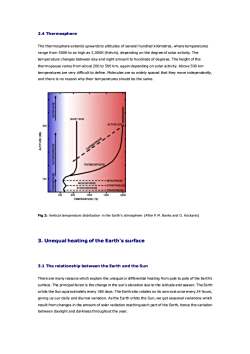
2.4 ThermosphereThethermosphereextendsupwardstoaltitudesofseveralhundredkilometres,wheretemperaturesrangefrom500Ktoashighas2,000K(Kelvin),dependingonthedegreeofsolaractivity.Thetemperaturechangesbetweendayandnightamounttohundredsofdegrees.Theheightofthethermopausevariesfromabout 200to50okm,againdependingonsolaractivity.Above500kmtemperatures are very difficult to define. Molecules are so widely spaced that they move independently,and there is no reason whytheirtemperaturesshould bethe same.ESOUIETSUNACTIVESU500)TOPAUSE_THERMORSOBEERTHERMOSFEO100ESOPAUSEMESOSPHERESTRATOPAUSSTRATOSPHEREC500100010015002000TEMPERATURE(K)Fig 2: Vertical temperature distribution in the Earth's atmosphere (After P.M. Banks and G. Kockarts)3.UnequalheatingoftheEarth'ssurface3.1TherelationshipbetweentheEarthandtheSunThere are many reasons which explain the unequalor differential heating from pole to pole of the Earth'ssurface.Theprincipalfactor is the change in the sun'selevation dueto the latitudeand season.The EarthorbitstheSunapproximatelyevery365days.TheEarthalsorotatesonitsownaxisonceevery24hours,giving us our daily and diurnal variation. As the Earth orbits the Sun,we get seasonalvariations whichresult fromchanges in the amount of solar radiation reaching each partof the Earth, hence the variationbetweendaylightanddarknessthroughouttheyear
2.4 Thermosphere The thermosphere extends upwards to altitudes of several hundred kilometres, where temperatures range from 500K to as high as 2,000K (Kelvin), depending on the degree of solar activity. The temperature changes between day and night amount to hundreds of degrees. The height of the thermopause varies from about 200 to 500 km, again depending on solar activity. Above 500 km temperatures are very difficult to define. Molecules are so widely spaced that they move independently, and there is no reason why their temperatures should be the same. Fig 2: Vertical temperature distribution in the Earth's atmosphere (After P.M. Banks and G. Kockarts) 3. Unequal heating of the Earth's surface 3.1 The relationship between the Earth and the Sun There are many reasons which explain the unequal or differential heating from pole to pole of the Earth’s surface. The principal factor is the change in the sun’s elevation due to the latitude and season. The Earth orbits the Sun approximately every 365 days. The Earth also rotates on its own axis once every 24 hours, giving us our daily and diurnal variation. As the Earth orbits the Sun, we get seasonal variations which result from changes in the amount of solar radiation reaching each part of the Earth, hence the variation between daylight and darkness throughout the year
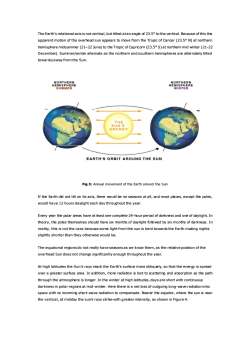
TheEarth'srotationalaxisisnotvertical,buttiltedatanangleof23.5otothevertical.Becauseofthistheapparentmotion oftheoverhead sun appearstomovefromtheTropicof Cancer(23.5N)atnorthernhemisphere midsummer (21-22 June) to the Tropic of Capricorn (23.5°S)at northern mid winter (21-22December). Summer/winter altermate as the northerm and southern hemispheres are alternately tiltedtowards/awayfromtheSun.NORTHERNNORTHERNHEMISPHEREHEMISPHERESUMMERWINTERTHESUN'SENERGYEARTH'SORBIT AROUNDTHESUNFig3:Annual movementoftheEartharoundtheSunIf the Earth did not tilt on its axis, there would be no seasons at all, and most places, except the poles,would have12hours daylighteachdaythroughouttheyear.Every year the polar areas have at least one complete 24-hour period of darkness and one of daylight. Intheory,thepolesthemselvesshouldhavesixmonthsofdaylightfollowedbysixmonthsofdarkness.Inreality,thisisnotthecasebecausesomelightfromthesunisbenttowardstheEarthmakingnightsslightly shorter than they otherwise would be.Theequatorialregionsdonotreallyhaveseasonsasweknowthem,astherelativepositionoftheoverhead Sundoesnotchange significantly enoughthroughouttheyear.At highlatitudes theSun's rays reach the Earth's surfacemoreobliquely,so that the energyis spreadover a greater surface area. In addition, more radiation is lost to scattering and absorption as the paththroughtheatmosphereislonger.Inthewinterathighlatitudes,daysareshortwithcontinuousdarkness in polarregions at mid-winter. Here there is a net loss of outgoing long-wave radiation intospace withno incoming short-waveradiationto compensate.Nearer theequator,where the sunisnearthe vertical, at midday the sun's rays strike with greater intensity, as shown in Figure 4
The Earth’s rotational axis is not vertical, but tilted at an angle of 23.5° to the vertical. Because of this the apparent motion of the overhead sun appears to move from the Tropic of Cancer (23.5° N) at northern hemisphere midsummer (21–22 June) to the Tropic of Capricorn (23.5° S) at northern mid winter (21-22 December). Summer/winter alternate as the northern and southern hemispheres are alternately tilted towards/away from the Sun. Fig 3: Annual movement of the Earth around the Sun If the Earth did not tilt on its axis, there would be no seasons at all, and most places, except the poles, would have 12 hours daylight each day throughout the year. Every year the polar areas have at least one complete 24-hour period of darkness and one of daylight. In theory, the poles themselves should have six months of daylight followed by six months of darkness. In reality, this is not the case because some light from the sun is bent towards the Earth making nights slightly shorter than they otherwise would be. The equatorial regions do not really have seasons as we know them, as the relative position of the overhead Sun does not change significantly enough throughout the year. At high latitudes the Sun’s rays reach the Earth’s surface more obliquely, so that the energy is spread over a greater surface area. In addition, more radiation is lost to scattering and absorption as the path through the atmosphere is longer. In the winter at high latitudes, days are short with continuous darkness in polar regions at mid-winter. Here there is a net loss of outgoing long-wave radiation into space with no incoming short-wave radiation to compensate. Nearer the equator, where the sun is near the vertical, at midday the sun’s rays strike with greater intensity, as shown in Figure 4
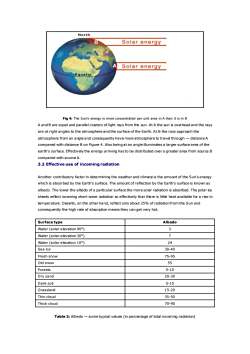
NorthBSolar energyASolar energyEquatoFig 4: The Sun's energy is more concentrated per unit area in A than it is in BA and B are equal and parallel clusters of light rays from the sun. At A the sun is overhead and the raysare at right angles to the atmosphere and the surface of the Earth. At B the rays approach theatmosphere from an angle and consequentlyhave moreatmosphere to travel through -distance Acompared with distance B on Figure 4.Also being atan angleilluminates a larger surfacearea of theearth's surface.Effectivelytheenergyarriving hastobedistributed overagreaterarea from sourceBcomparedwithsourceA.3.2Effectiveuseof incomingradiationAnother contributory factorin determining the weather and climate is the amountof the Sun's energywhichisabsorbedbytheEarth'ssurface.TheamountofreflectionbytheEarth'ssurfaceisknownasalbedo. The lower the albedo of a particular surface the more solar radiation is absorbed. The polar icesheets reflect incoming short-wave radiation so effectively that there is little heat available for a rise intemperature.Deserts,ontheotherhand,reflectonlyabout25%ofradiationfromtheSunandconsequently the high rate of absorption means they can get very hot.SurfacetypeAlbedo3Water (solarelevation90°)7Water (solar elevation 300)24Water (solarelecation10°)Sea ice30-4075-95Freshsnow55OldsnowForests5-1020-30Dry sand5-15Dark soil15-20Grassland35-50Thin cloud70-90Thick cloudTable 2: Albedo some typical values (in percentage of total incoming radiation)
Fig 4: The Sun's energy is more concentrated per unit area in A than it is in B A and B are equal and parallel clusters of light rays from the sun. At A the sun is overhead and the rays are at right angles to the atmosphere and the surface of the Earth. At B the rays approach the atmosphere from an angle and consequently have more atmosphere to travel through — distance A compared with distance B on Figure 4. Also being at an angle illuminates a larger surface area of the earth’s surface. Effectively the energy arriving has to be distributed over a greater area from source B compared with source A. 3.2 Effective use of incoming radiation Another contributory factor in determining the weather and climate is the amount of the Sun’s energy which is absorbed by the Earth’s surface. The amount of reflection by the Earth's surface is known as albedo. The lower the albedo of a particular surface the more solar radiation is absorbed. The polar ice sheets reflect incoming short-wave radiation so effectively that there is little heat available for a rise in temperature. Deserts, on the other hand, reflect only about 25% of radiation from the Sun and consequently the high rate of absorption means they can get very hot. Surface type Albedo Water (solar elevation 90°) 3 Water (solar elevation 30°) 7 Water (solar elecation 10°) 24 Sea ice 30-40 Fresh snow 75-95 Old snow 55 Forests 5-10 Dry sand 20-30 Dark soil 5-15 Grassland 15-20 Thin cloud 35-50 Thick cloud 70-90 Table 2: Albedo — some typical values (in percentage of total incoming radiation)
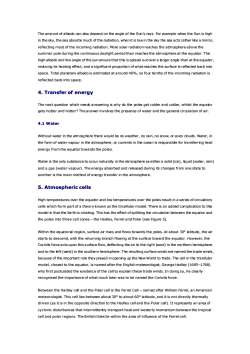
Theamount of albedo can also depend on the angle of the Sun's rays.For example when the Sun is highin the sky,the sea absorbsmuch of theradiation, when it is lowin the sky the sea acts rather like a mirrorreflecting most of the incoming radiation.More solarradiationreaches the atmosphereabove thesummer pole during the continuous daylight period than reaches the atmosphere at the equator. Thehighalbedo and low angleofthe sun ensurethatthis is spread out overa largerangle than at the equator,reducing its heating effect, and a significant proportion of whatreaches the surface is reflected back intospace.Total planetary albedo is estimated at around 40%,so four tenths of the incoming radiation isreflectedbackintospace4.TransferofenergyThe next question which needs answering is why do the poles get colder and colder, whilst the equatorgets hotter and hotter? Theanswerinvolves the presence ofwater and the general circulation of air.4.1 WaterWithoutwaterintheatmospheretherewouldbenoweather,norain,no snow,orevenclouds.Water,intheform of watervapour in the atmosphere,or currents in the ocean is responsiblefor transferring heatenergyfromtheequatortowardsthepoles.Water is the only substance to occur naturally in the atmosphereas eithera solid (ice),liquid (water,rain)and a gas (water vapour).Theenergy absorbed and released during its changes from one statetoanother is themainmethodofenergytransfer in theatmosphere.5.AtmosphericcellsHightemperaturesovertheequatorandlowtemperaturesoverthepolesresultinaseriesofcirculatorycellswhichformpartofatheoryknownasthetricellularmodel.Thereisanaddedcomplicationtothismodel in that the Earth is rotating.This has theeffectof splitting the circulationbetween theequatorandthe poles into three cell zones -the Hadley, Ferrel and Polar (see Figure 5)Within the equatorial region, surface air rises and flows towards the poles. At about 30 latitude, the airstarts to descend,with the returning branch flowing at the surfacetowardthe equator.However, theCoriolis forceacts upon this surfaceflow,deflecting theairto theright (east) in the northerm hemisphereand to the left (west) in the southern hemisphere. The resulting surface winds are named the trade winds,because of the important role they played in opening up the New World to trade.The cell in the tricellularmodel,closesttotheequator,isnamedaftertheEnglishmeteorologist,GeorgeHadley(1685-1768)whofirstpostulatedtheexistenceofthecelltoexplainthesetradewinds.Indoingso,heclearlyrecognised the importanceofwhatmuchlaterwastobenamed the CoriolisforceBetween the Hadley cell and the Polarcell is the Ferrel Cell -named after William Ferrel, an Americanmeteorologist.This cell lies betweenabout30toabout 60°latitude,and it isnotdirectly thermallydriven(asitisintheoppositedirectiontotheHadleycellandthePolarcell).Itrepresentsanareaofcyclonic disturbances that intermittently transport heat and westerly momentum between the tropicalcell and polar regions. The British Isles lie within the area of influence of the Ferrel cell
The amount of albedo can also depend on the angle of the Sun’s rays. For example when the Sun is high in the sky, the sea absorbs much of the radiation, when it is low in the sky the sea acts rather like a mirror, reflecting most of the incoming radiation. More solar radiation reaches the atmosphere above the summer pole during the continuous daylight period than reaches the atmosphere at the equator. The high albedo and low angle of the sun ensure that this is spread out over a larger angle than at the equator, reducing its heating effect, and a significant proportion of what reaches the surface is reflected back into space. Total planetary albedo is estimated at around 40%, so four tenths of the incoming radiation is reflected back into space. 4. Transfer of energy The next question which needs answering is why do the poles get colder and colder, whilst the equator gets hotter and hotter? The answer involves the presence of water and the general circulation of air. 4.1 Water Without water in the atmosphere there would be no weather, no rain, no snow, or even clouds. Water, in the form of water vapour in the atmosphere, or currents in the ocean is responsible for transferring heat energy from the equator towards the poles. Water is the only substance to occur naturally in the atmosphere as either a solid (ice), liquid (water, rain) and a gas (water vapour). The energy absorbed and released during its changes from one state to another is the main method of energy transfer in the atmosphere. 5. Atmospheric cells High temperatures over the equator and low temperatures over the poles result in a series of circulatory cells which form part of a theory known as the tricellular model. There is an added complication to this model in that the Earth is rotating. This has the effect of splitting the circulation between the equator and the poles into three cell zones – the Hadley, Ferrel and Polar (see Figure 5). Within the equatorial region, surface air rises and flows towards the poles. At about 30° latitude, the air starts to descend, with the returning branch flowing at the surface toward the equator. However, the Coriolis force acts upon this surface flow, deflecting the air to the right (east) in the northern hemisphere and to the left (west) in the southern hemisphere. The resulting surface winds are named the trade winds, because of the important role they played in opening up the New World to trade. The cell in the tricellular model, closest to the equator, is named after the English meteorologist, George Hadley (1685–1768) who first postulated the existence of the cell to explain these trade winds. In doing so, he clearly recognised the importance of what much later was to be named the Coriolis force. Between the Hadley cell and the Polar cell is the Ferrel Cell – named after William Ferrel, an American meteorologist. This cell lies between about 30° to about 60° latitude, and it is not directly thermally driven (as it is in the opposite direction to the Hadley cell and the Polar cell). It represents an area of cyclonic disturbances that intermittently transport heat and westerly momentum between the tropical cell and polar regions. The British Isles lie within the area of influence of the Ferrel cell
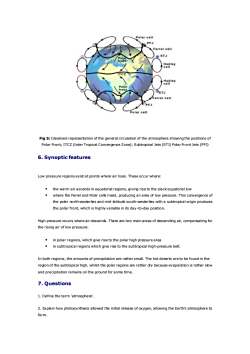
PolarcellPFJFerrel cellSTJHadleyAcellTCHadleycellPolarronBSTJFerrel cellPFJolarcellFig5:IdealisedrepresentationofthegeneralcirculationoftheatmosphereshowingthepositionsofPolar Front; ITCZ (InterTropical ConvergenceZone);Subtropical Jets(STJ)PolarFrontJets (PFJ)6.SynopticfeaturesLowpressureregionsexistatpointswhereairrises.Theseoccurwherethewarmairascends inequatorial regions,giving riseto the slackequatorial low1where the Ferreland Polar cells meet, producing an area of low pressure.This convergence ofthe polar north-easterlies and mid-latitude south-westerlies with a subtropicalorigin producesthe polar front, which is highly variable in its day-to-day position.High pressure occurs where air descends.There are two mainareas of descending air, compensating fortherisingairof lowpressure:inpolarregions,whichgiverisetothepolarhighpressureareain subtropical regions which give riseto the subtropical high-pressure belt.In both regions,the amounts of precipitation arerather small.The hotdeserts are to be found in theregion of the subtropical high, whist the polar regions are rather dry because evaporation is rather slowandprecipitationremainsonthegroundforsometime7.Questions1.Definetheterm'atmosphere'.2. Explain how photosynthesis allowed the initial release of oxygen, allowing the Earth's atmosphere toform
Fig 5: Idealised representation of the general circulation of the atmosphere showing the positions of Polar Front; ITCZ (Inter Tropical Convergence Zone); Subtropical Jets (STJ) Polar Front Jets (PFJ) 6. Synoptic features Low pressure regions exist at points where air rises. These occur where: ▪ the warm air ascends in equatorial regions, giving rise to the slack equatorial low ▪ where the Ferrel and Polar cells meet, producing an area of low pressure. This convergence of the polar north-easterlies and mid-latitude south-westerlies with a subtropical origin produces the polar front, which is highly variable in its day-to-day position. High pressure occurs where air descends. There are two main areas of descending air, compensating for the rising air of low pressure: ▪ in polar regions, which give rise to the polar high pressure area ▪ in subtropical regions which give rise to the subtropical high-pressure belt. In both regions, the amounts of precipitation are rather small. The hot deserts are to be found in the region of the subtropical high, whilst the polar regions are rather dry because evaporation is rather slow and precipitation remains on the ground for some time. 7. Questions 1. Define the term 'atmosphere'. 2. Explain how photosynthesis allowed the initial release of oxygen, allowing the Earth's atmosphere to form

3.What isozone?What importantroledoes itperform?4.Which of thefollowing arethe two major gases in the Earth's atmosphere-nitrogen, hydrogen,oxygen,methane or carbon dioxide?5.Arrangethefollowing atmospheric layers into thecorrect order,starting with the layer,nearesttheEarth's surface-mesosphere,stratosphere,troposphere,thermosphere.6.What is meant by the term'adiabatic cooling'?7.How high is the troposphere over the equator-4,8,16or 32km?8.Dotemperaturesincrease,ordecreasewithincreasingaltitude,inthestratosphere?9.How high is the troposphere over the poles -4, 8,16 or 32km?10.Explain the differences between nacreous and noctilucent clouds11. Describe how the Earth's tilt and rotational axis causes differences in the amount of heat received atthe Earth's surface.12. What is albedo? How does it vary with different types of surface?13. Whatare trade winds?14.Describethefactorswhichcause:(a) high pressure, and(b) lowpressure
3. What is ozone? What important role does it perform? 4. Which of the following are the two major gases in the Earth's atmosphere – nitrogen, hydrogen, oxygen, methane or carbon dioxide? 5. Arrange the following atmospheric layers into the correct order, starting with the layer, nearest the Earth's surface – mesosphere, stratosphere, troposphere, thermosphere. 6. What is meant by the term 'adiabatic cooling'? 7. How high is the troposphere over the equator – 4, 8, 16 or 32 km? 8. Do temperatures increase, or decrease with increasing altitude, in the stratosphere? 9. How high is the troposphere over the poles – 4, 8, 16 or 32 km? 10. Explain the differences between nacreous and noctilucent clouds. 11. Describe how the Earth's tilt and rotational axis causes differences in the amount of heat received at the Earth's surface. 12. What is albedo? How does it vary with different types of surface? 13. What are trade winds? 14. Describe the factors which cause: (a) high pressure, and (b) low pressure
按次数下载不扣除下载券;
注册用户24小时内重复下载只扣除一次;
顺序:VIP每日次数-->可用次数-->下载券;
- 《农业气象学》课程教学资源(文献资料)Thunderstorms.doc
- 《农业气象学》课程教学资源(文献资料)Weather forecasting.doc
- 《农业气象学》课程教学资源(文献资料)Clouds 2/2.doc
- 《农业气象学》课程授课教案(石河子大学:胡晓棠).doc
- 《农业气象学》课程教学大纲(农学院各类专业用).pdf
- 《农业信息技术》课程教学课件(讲稿)第二章 精准农业技术.pdf
- 《农业信息技术》课程教学课件(讲稿)第四章 遥感技术.pdf
- 《农业信息技术》课程教学课件(讲稿)第一章 绪论.pdf
- 《农业信息技术》课程教学课件(讲稿)第三章 全球定位系统与应用(Global Positioning System,GPS).pdf
- 《农业信息技术》课程教学课件(讲稿)第七章 作物模拟模型.pdf
- 《农业信息技术》课程教学课件(讲稿)第八章 农业专家系统.pdf
- 《农业信息技术》课程教学课件(讲稿)第六章 决策支持系统.pdf
- 《农业信息技术》课程教学课件(讲稿)第五章 地理信息系统.pdf
- 《农业信息技术》课程授课教案(石河子大学:蒋桂英).pdf
- 《农业信息技术》课程教学资源(讲义,共八章).pdf
- 《农业信息技术》课程教学大纲 Agricultural Information Technology.pdf
- 《种子生产学》课程教学资源(文献资料)水稻的一生.doc
- 《种子生产学》课程教学课件(PPT讲稿)玉米授粉过程.ppt
- 《种子生产学》课程教学课件(PPT讲稿)玉米杂交种生产技术.ppt
- 《种子生产学》课程教学课件(PPT讲稿)异花授粉农作物的种子生产(玉米种子生产技术).ppt
- 《农业气象学》课程教学资源(文献资料)Agrometeorology.doc
- 《农业气象学》课程教学资源(文献资料)Air masses.doc
- 《农业气象学》课程教学资源(文献资料)Clouds 1/2.doc
- 《农业气象学》课程教学课件(PPT讲稿)第四章 大气中的水分.ppt
- 《农业气象学》课程教学课件(PPT讲稿)第五章 气压与风.ppt
- 《农业气象学》课程教学课件(PPT讲稿)第三章 热量.ppt
- 《农业气象学》课程教学课件(PPT讲稿)第二章 辐射.ppt
- 《农业气象学》课程教学课件(PPT讲稿)第六章 天气及农业气象灾害.ppt
- 《农业气象学》课程教学课件(PPT讲稿)第一章 大气.ppt
- 《农业气象学》课程教学课件(PPT讲稿)第七章 气候与农业气候.ppt
- 《耕作学》课程教学大纲 Farming System(农学专业).docx
- 《耕作学》课程考试大纲 Testing Principle Farming System.pdf
- 《耕作学》课程授课教案(石河子大学:刘建国).doc
- 《耕作学》课程课程习题集(含参考答案).doc
- 《耕作学》课程教学资源(PPT课件)第十章 耕作制度发展与趋势展望.ppt
- 《耕作学》课程教学资源(PPT课件)第十一章 信息技术在现代农业中的应用.ppt
- 《耕作学》课程教学资源(PPT课件)第九章 土壤耕作 Soil Tillage.ppt
- 《耕作学》课程教学资源(PPT课件)第八章 农田养护 Conservation of crop land.ppt
- 《耕作学》课程教学资源(PPT课件)第六章 轮作与连作.ppt
- 《耕作学》课程教学资源(PPT课件)第七章 农牧结合的种植制度.ppt
